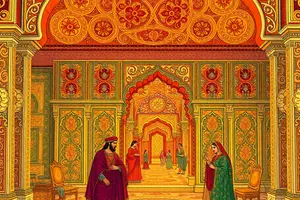Podcast
Questions and Answers
True or false: The big cycle typically lasts about 100 years.
True or false: The big cycle typically lasts about 100 years.
False (B)
True or false: Ray Dalio learned to anticipate the future by studying the past.
True or false: Ray Dalio learned to anticipate the future by studying the past.
True (A)
True or false: Buying stocks, gold, and commodities is not a good strategy when central banks print a lot of money to relieve a crisis.
True or false: Buying stocks, gold, and commodities is not a good strategy when central banks print a lot of money to relieve a crisis.
False (B)
True or false: The American world order formed after the allied victory in World War I.
True or false: The American world order formed after the allied victory in World War I.
True or false: The big cycle is driven by a pattern of cause-effect relationships that drive the rise and decline of a typical empire.
True or false: The big cycle is driven by a pattern of cause-effect relationships that drive the rise and decline of a typical empire.
True or false: Wealth gaps tend to shrink as an empire becomes richer and less productive.
True or false: Wealth gaps tend to shrink as an empire becomes richer and less productive.
True or false: The US has military bases in fewer than 50 countries.
True or false: The US has military bases in fewer than 50 countries.
True or false: The cycle of borrowing from poorer countries leads to deeper debt.
True or false: The cycle of borrowing from poorer countries leads to deeper debt.
Flashcards are hidden until you start studying
Study Notes
- The times ahead will be different from those experienced in our lifetimes, but similar to past events.
- Ray Dalio learned to anticipate the future by studying the past.
- When central banks print a lot of money to relieve a crisis, buy stocks, gold and commodities because their value will rise.
- Internal and world orders typically change after wars, when revolutionary new forces defeat weak old orders.
- The current world order, commonly called the American world order, formed after the allied victory in World War II.
- Changes in internal and world orders take place in a timeless and universal cycle called the big cycle.
- The big cycle typically lasts about 250 years with 10 to 20 year transition periods between them.
- Better education leads to increased innovation and technology development, and with a lag, the establishment of the currency as a reserve currency.
- The big cycle typically begins after a major conflict, often a war.
- The big cycle is driven by a pattern of cause-effect relationships that drive the rise and decline of a typical empire.The text describes the typical cycle of rise, top, and decline of empires, which is driven by cause and effect relationships. Successful empires rise by gaining power, consolidating power, establishing systems and institutions, and picking good successors. Education, innovation, and strong capital markets are key to their success. They become the world's leading financial centers and their currency becomes the preferred global medium of exchange, leading to more borrowing and a financial bubble. The empire's share of trade grows, but its competitiveness declines as its people become richer and less productive. Wealth gaps grow and resentment builds, but conflict is avoided as long as living standards rise. Eventually, excessive borrowing weakens the empire's financial health, leading to its decline.1. Having a large empire can become unprofitable.
- The Dutch and British empires overextended and lost their competitive advantages.
- The US has spent trillions on foreign wars and military operations.
- The US is not spending enough to compete with China.
- Richer countries borrow from poorer countries and get deeper into debt.
- This is a sign of a wealth and power shift.
- The US started borrowing from China in the 1980s.
- The US had a per capita income 40 times greater than China's at the time.
- The US has military bases in 70 countries.
- The cycle of borrowing from poorer countries leads to deeper debt.
Studying That Suits You
Use AI to generate personalized quizzes and flashcards to suit your learning preferences.




